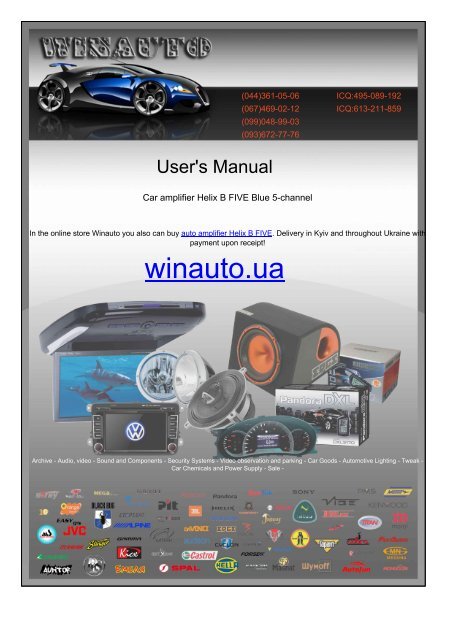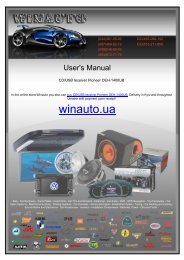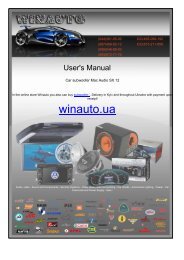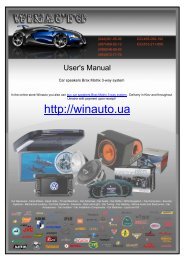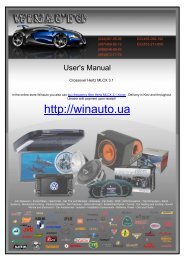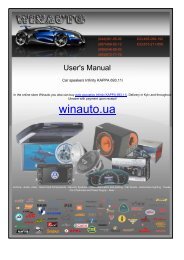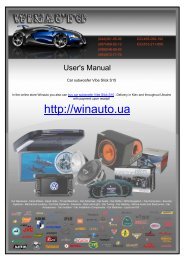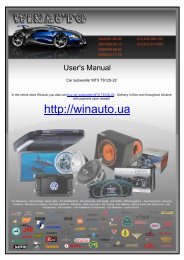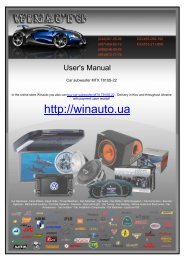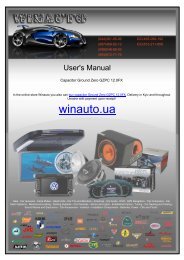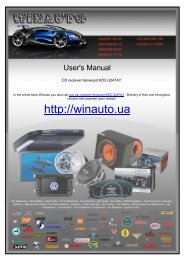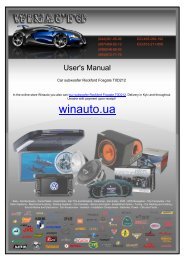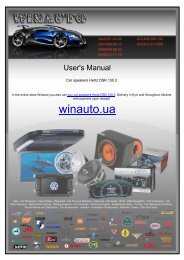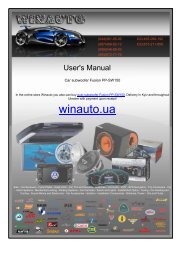Car amplifier Helix B FIVE Blue 5-channel
Car amplifier Helix B FIVE Blue 5-channel
Car amplifier Helix B FIVE Blue 5-channel
You also want an ePaper? Increase the reach of your titles
YUMPU automatically turns print PDFs into web optimized ePapers that Google loves.
(044)361-05-06<br />
(067)469-02-12<br />
(099)048-99-03<br />
(093)672-77-76<br />
ICQ:495-089-192<br />
ICQ:613-211-859<br />
User's Manual<br />
<strong>Car</strong> <strong>amplifier</strong> <strong>Helix</strong> B <strong>FIVE</strong> <strong>Blue</strong> 5-<strong>channel</strong><br />
In the online store Winauto you also can buy auto <strong>amplifier</strong> <strong>Helix</strong> B <strong>FIVE</strong>. Delivery in Kyiv and throughout Ukraine with<br />
payment upon receipt!<br />
winauto.ua<br />
Archive - Audio, video - Sound and Components - Security Systems - Video observation and parking - <strong>Car</strong> Goods - Automotive Lighting - Tweak -<br />
<strong>Car</strong> Chemicals and Power Supply - Sale -
Online-store car audio and autogoods Winauto<br />
BEDIENUNGSANLEITUNG<br />
INSTRUCTION MANUAL<br />
blue<br />
winauto.ua<br />
deutsch/english<br />
B <strong>FIVE</strong><br />
5-Kanal Verstärker<br />
5-Channel Amplifier
Online-store car audio and autogoods Winauto<br />
DEUTSCH<br />
Sehr geehrter Kunde,<br />
wir gratulieren Ihnen zum Kauf dieses hochwertigen<br />
HELIX B <strong>FIVE</strong> Verstärkers.<br />
Er wurde nach neuesten technischen Erkenntnissen entwickelt<br />
und zeichnet sich durch hervorragende<br />
Verarbeitung und überzeugende Technologie aus. Sein<br />
ausgezeichnetes Preis-Leistungsverhältnis setzt ebenfalls<br />
neue Maßstäbe und macht ihn zum idealen Allround-<br />
Verstärker in der Highpowerklasse.<br />
Die HELIX B <strong>FIVE</strong> besteht aus einer 4-Kanal Sektion mit<br />
integrierter, aktiver regelbarer Hochpassweiche für Kanal 1<br />
und 2 und einer Aktivweiche mit Hochpass, Tiefpass und<br />
Bandpass für Kanal 3 und 4. Der Verstärker ist brückbar<br />
und ermöglicht dadurch weitere Anschlussoptionen.<br />
Kanal 5 ist ein analoger Mono Basskanal mit integrierter,<br />
aktiver regelbarer Frequenzweiche für Tiefpass und integriertem<br />
Bass Boost.<br />
Viel Spaß mit diesem Produkt wünscht Ihnen das Team von<br />
AUDIOTEC FISCHER<br />
Allgemeines zum Einbau von HELIX-Verstärkern<br />
Um alle Möglichkeiten optimal ausschöpfen zu können,<br />
lesen Sie bitte sorgfältig die nachfolgenden Installationshinweise.<br />
Wir garantieren, dass jedes Gerät vor Versand<br />
auf seinen einwandfreien Zustand überprüft wurde.<br />
Vor Beginn der Installation unterbrechen Sie den Minusanschluss<br />
der Autobatterie. Wir empfehlen Ihnen die<br />
Installation von einem Einbauspezialisten vornehmen zu<br />
lassen, da der Nachweis eines fachgerechten Einbaus und<br />
Anschlusses des Gerätes Voraussetzung für die Garantieleistungen<br />
sind.<br />
Installieren Sie Ihren Verstärker an einer trockenen Stelle<br />
im Auto und vergewissern Sie sich, dass der Verstärker am<br />
Montageort genügend Kühlung erhält. Montieren Sie das<br />
Gerät nicht in zu kleine, abgeschlossene Gehäuse ohne<br />
Luftzirkulation oder in der Nähe von wärmeabstrahlenden<br />
Teilen oder elektronischen Steuerungen des Fahrzeuges.<br />
Im Sinne der Unfallsicherheit muß der Verstärker professionell<br />
befestigt werden. Dieses geschieht über die 4 beiliegenden<br />
Schrauben, die in eine Montagefläche eingeschraubt<br />
werden, die genügend Halt bieten muss. Bevor<br />
Sie die Schrauben im Montagefeld befestigen, vergewissern<br />
Sie sich, dass keine elektrischen Kabel und<br />
Komponenten, hydraulische Bremsleitungen, der<br />
Benzintank etc. dahinter verborgen sind. Diese könnten<br />
sonst beschädigt werden. Achten Sie darauf, daß solche<br />
Teile sich auch in der doppelten Wandverkleidung verbergen<br />
können.<br />
Allgemeines zum Anschluss der Verstärker<br />
Der Verstärker darf nur in Kraftfahrzeuge eingebaut werden,<br />
die den 12V Minuspol an Masse haben. Bei anderen<br />
Systemen können der Verstärker und die elektrische<br />
Anlage des Kfz beschädigt werden.<br />
Die Plusleitung für die gesamte Anlage sollte in einem<br />
Abstand von max. 30 cm von der Batterie mit einer<br />
Hauptsicherung abgesichert werden. Der Wert der<br />
Sicherung errechnet sich aus der maximalen Stromaufnahme<br />
der <strong>Car</strong>-Hifi Anlage. Die Kabelverbindungen<br />
müssen so verlegt sein, daß keine Klemm-, Quetsch-oder<br />
Bruchgefahr besteht. Bei scharfen Kanten (Blechdurchführungen)<br />
müssen alle Kabel gegen Durchscheuern<br />
gepolstert sein.<br />
Ferner dürfen die Stromversorgungskabel niemals mit<br />
Zuleitungen zu Vorrichtungen des Kfz (Lüftermotoren,<br />
Brandkontrollmodulen, Benzinleitungen etc.) verlegt werden.<br />
Um eine sichere Installation zu gewährleisten, sollte auf<br />
hohe Qualität der verwendeten Anschlussmaterialien<br />
geachtet werden.<br />
winauto.ua<br />
2
Online-store car audio and autogoods Winauto<br />
winauto.ua
Online-store car audio and autogoods Winauto<br />
1 Power/Protect LED<br />
6 Lautsprecheranschlussklemmen<br />
Die Power/Protect LED zeigt den Betriebszustand des Verstärkers<br />
an. Leuchtet die LED grün, ist der Verstärker eingeschaltet<br />
und betriebsbereit. Bei rot leuchtender LED besteht<br />
eine Fehlfunktion des Verstärkers.<br />
Diese Fehlfunktion kann unterschiedliche Ursachen<br />
haben, da die HELIX B <strong>FIVE</strong> mit verschiedenen elektronischen<br />
Schutzschaltungen ausgestattet ist. Sie schalten<br />
den Verstärker bei Überhitzung, Über- und Unterspannung,<br />
Kurzschluss am Lautsprecherausgang, Impedanzunterschreitung<br />
und Fehlanschluss ab.<br />
Prüfen Sie in diesem Fall alle Anschlüsse auf Fehler, wie<br />
z.B. Kurzschlüsse, fehlerhafte Verbindungen oder Falscheinstellungen<br />
und Übertemperatur. Sollte sich der Verstärker<br />
nach der Beseitigung der Fehlerquelle nicht wieder<br />
einschalten lassen, liegt ein Defekt vor und das Gerät muß<br />
mit Fehlerbeschreibung und Kaufbeleg zur Reparatur an<br />
den Händler zurückgegeben werden.<br />
2 Anschluss Massekabel<br />
Das Massekabel sollte am zentralen Massepunkt (dieser<br />
befindet sich dort wo der Minuspol der Batterie zum<br />
Metallchassis des Kfz geerdet ist) oder an einer blanken,<br />
von Lackresten befreiten Stelle des Kfz-Chassis angeschlossen<br />
werden. Der empfohlene Querschnitt beträgt<br />
mindestens 25 mm 2 .<br />
3 Anschluss Remoteleitung<br />
Die Remoteleitung wird mit dem automatischen Antennenanschluss<br />
des Steuergerätes (Radio) verbunden. Dieser ist<br />
nur aktiviert, wenn das Steuergerät EIN-geschaltet ist.<br />
Somit wird der Verstärker mit dem Steuergerät ein- und ausgeschaltet.<br />
4 Anschluss Batteriekabel<br />
Das +12V Versorgungskabel ist am Pluspol der Batterie<br />
anzuschließen. Der empfohlene Querschnitt beträgt<br />
mindestens 25 mm 2 .<br />
5 Sicherungen<br />
Die Eingangssicherungen sind parallel geschaltet und schützen<br />
vor einem geräteinternen Fehler, d.h. die Anlage muss mit<br />
einer zusätzlichen Sicherung in Nähe der Batterie (max. 30 cm<br />
entfernt) abgesichert werden.<br />
Der Sicherungswert für die HELIX B <strong>FIVE</strong> beträgt 3 x 30 Ampere.<br />
Zum Anklemmen der Lautsprecherleitungen.<br />
Siehe Anschlussdiagramme Seite 6.<br />
Verbinden Sie niemals die Lautsprecherleitungen mit der Kfz-<br />
Masse (Fahrzeugkarosserie). Dieses kann Ihren Verstärker<br />
zerstören. Achten Sie darauf, dass alle Lautsprechersysteme<br />
phasenrichtig angeschlossen sind, d.h. Plus zu<br />
Plus und Minus zu Minus. Vertauschen von Plus und<br />
Minus hat einen Totalverlust der Basswiedergabe zur<br />
Folge. Der Pluspol ist bei den meisten Lautsprechern<br />
gekennzeichnet.<br />
Die Impedanz pro Kanal sollte 2 Ohm nicht unterschreiten,<br />
da die Schutzelektronik den Verstärker sonst abschaltet.<br />
7 & 22 Signaleingänge<br />
Die HELIX B <strong>FIVE</strong> besitzt 6 Cinch-Eingänge (RCA-<br />
Anschlüsse) als Signaleingänge, die mit den Vorverstärkerausgängen<br />
/ Line Outputs des Steuergerätes (Headunit,<br />
Prozessor, etc.) verbunden werden können.<br />
Bitte beachten Sie, dass aus den letzten beiden Signaleingängen<br />
(Kanal 5 „L“ und „R“) ein Summensignal für<br />
den 5. Kanal gebildet wird.<br />
8 Hochpegel-Lautsprechereingänge<br />
Die HELIX B <strong>FIVE</strong> besitzt zusätzlich vier Hochpegel-<br />
Lautsprechereingänge, die direkt mit den Lautsprecherausgängen<br />
der Headunit verbunden werden können.<br />
Es wird empfohlen den Highlevel-Eingang ausschließlich<br />
mit dem beiliegenden Anschlusskabel oder mit den optional<br />
erhältlichen HELIX-Kabelbäumen zu verwenden, um<br />
einen Fehlanschluss sowie eine Beschädigung des<br />
Anschlusses zu vermeiden.<br />
winauto.ua<br />
9 Eingangssignalschalter<br />
2-Kanal - 4-Kanal - 5-Kanal Modus<br />
2-Kanal Modus: Bei Radios mit einem Stereoausgang werden<br />
alle Kanäle des Verstärkers mit diesem Signal versorgt,<br />
d.h. es muss nur der erste und zweite Cinch bzw.<br />
Highlevel-Eingangskanal belegt werden. In diesem Modus<br />
wird das Eingangssignal von Kanal 1 parallel auf Kanal<br />
3 und das von Kanal 2 parallel auf Kanal 4 weitergeleitet.<br />
Für den 5. Kanal (Subwooferausgang) wird aus dem<br />
Eingangssignal von Kanal 1 und 2 ein Summensignal<br />
gebildet. Bitte beachten Sie, dass sich die Fader- und<br />
Balanceregler des Steuergerätes somit gleichermaßen auf<br />
Kanal 3 bzw. 4 auswirken, wie auf Kanal 1 und 2.<br />
4
Online-store car audio and autogoods Winauto<br />
4-Kanal Modus: Bei Radios mit 2 Stereoausgängen wird<br />
jeder der 4 Lautsprecherausgänge mit dem dazugehörigem<br />
Eingangssignal versorgt. Der 5. Kanal (Subwooferausgang)<br />
wird mit einem Summensignal der 4 Eingangssignale<br />
versorgt.<br />
5-Kanal Modus: Hierbei müssen alle Cinch-Eingänge bzw.<br />
Highlevel-Eingänge belegt werden, also alle 5 Kanäle. Da<br />
der 5. Kanal einen Stereoeingang besitzt, sollten beide<br />
Eingänge belegt werden. Für den Fall, dass nur ein<br />
Eingang belegt wird, muss die Eingangsempfindlichkeit<br />
angepasst werden.<br />
13 Frequenzeinstellregler für Hochpass<br />
Kanal 1 und 2<br />
Zur Einstellung der Trennfrequenz von 15 Hz bis 4000 Hz.<br />
Dieser Regler wird erst aktiviert, wenn Schalter 12 auf<br />
HPF (Hochpassfilter) eingestellt ist.<br />
variabel<br />
2K<br />
5K<br />
Hz<br />
Im 5-Kanal Modus muss bei Verwendung der Highlevel-<br />
Eingänge zusätzlich der 5. Cincheingang belegt werden.<br />
10, 14 & 21 Levelregler für Eingangsempfindlichkeit<br />
Kanäle 1 bis 5<br />
Mit Hilfe dieser Regler kann die Eingangsempfindlichkeit<br />
der Kanäle an die Ausgangsspannung des angeschlossenen<br />
Steuergeräts angepasst werden. Diese Regler sind<br />
keine Lautstärkeregler, sondern dienen nur der<br />
Anpassung. Der Regelbereich beträgt 0,2 bis 6 Volt.<br />
Mit dem Regler 10 können die Kanäle 1 und 2 eingestellt<br />
werden, mit dem Regler 14 die Kanäle 3 und 4 und<br />
Kanal 5 mit dem Regler 21.<br />
11, 15 & 20 Regler für Bassanhebung Kanäle 1 bis 5<br />
Mit Hilfe dieser Regler kann das Basssignal bei 45 Hz von<br />
0 bis 18 dB angehoben werden.<br />
15 Hz 4 kHz<br />
16 Umschalter für Hochpass - Fullrange - Tiefpass /<br />
Bandpass Kanal 3 und 4<br />
Zur Umschaltung der internen, aktiven Frequenzweiche<br />
auf Hochpass, Fullrange oder Tiefpass bzw. Bandpass.<br />
Wird dieser Schalter auf HPF (Hochpass) gestellt, so kann<br />
mit Hilfe des Reglers 11 die exakte Übernahmefrequenz<br />
für den Hochpass eingestellt werden.<br />
Bei Schalterstellung FULL (Fullrange) ist die interne<br />
Frequenzweiche nicht aktiv.<br />
Bei Schalterstellung LPF (Tiefpassfilter) ist der Hochpass<br />
immer aktiv. Das heißt, es wird in jedem Fall ein Bandpass<br />
gebildet. Mit dem Regler 17 wird der Hochpass und mit dem<br />
Regler 18 der Tiefpass eingestellt. So kann jeder beliebige<br />
Bandpass zwischen 15 Hz und 4000 Hz eingestellt werden.<br />
Achtung! Bitte vergewissern Sie sich, dass beim Einstellen<br />
eines Bandpasses die Übernahmefrequenzen von Hoch- und<br />
Tiefpass 2 Oktaven auseinander liegen, um einen Pegelverlust<br />
zu vermeiden! Die eingestellte Frequenz des<br />
Tiefpasses muss immer höher sein als die des Hochpasses!<br />
Das heißt: Wird das Tiefpasssignal z. B. auf 320 Hz eingestellt,<br />
so sollte der Hochpass um 2 Oktaven tiefer auf ca. 80 Hz<br />
eingestellt werden (1 Oktave = Frequenzverdopplung oder<br />
Frequenzhalbierung).<br />
winauto.ua<br />
12 Umschalter für Fullrange - Hochpass Kanal 1 und 2<br />
Zur Umschaltung der internen, aktiven Frequenzweiche<br />
auf Hochpass oder Fullrange.<br />
Wird der Schalter auf HPF (Hochpassfilter) gestellt, so kann<br />
mit Hilfe des Reglers 13 die exakte Übernahmefrequenz<br />
für den Hochpass eingestellt werden.<br />
Bei der Schalterstellung FULL (Fullrange) ist die interne<br />
Frequenzweiche nicht aktiv.<br />
Für den Kanal 1 und 2 ist es nicht möglich einen Tiefpassfilter<br />
einzustellen, da diese Kanäle speziell für den Betrieb<br />
von Hochtönern optimiert wurden, sofern der Schalter auf<br />
HPF gestellt wird.<br />
17 Frequenzeinstellregler für Hochpass<br />
Kanal 3 und 4<br />
Zur Einstellung der Trennfrequenz von 15 Hz bis 4000 Hz.<br />
Dieser Regler wird erst aktiviert, wenn Schalter 12 auf HPF<br />
(Hochpassfilter) eingestellt ist.<br />
variabel<br />
15 Hz 4 kHz<br />
2K<br />
5K<br />
Hz<br />
5
Online-store car audio and autogoods Winauto<br />
18 Frequenzeinstellregler für Tiefpass / Bandpass<br />
Kanal 3 und 4<br />
Zur Einstellung der Trennfrequenz von 40 Hz bis 4000 Hz.<br />
Dieser Regler wird erst aktiviert, wenn Schalter 12 auf LPF<br />
(Lowpassfilter) eingestellt ist.<br />
19 Frequenzeinstellregler für Tiefpass<br />
Kanal 5<br />
Zur Einstellung der Trennfrequenz von 40 Hz bis 4000 Hz.<br />
Dieser Regler ist immer aktiv.<br />
variabel<br />
variabel<br />
2K<br />
5K<br />
Hz<br />
2K<br />
5K<br />
Hz<br />
40 Hz 4 kHz<br />
40 Hz 4 kHz<br />
Kanal 3 Kanal 4<br />
ANSCHLUSS DER LAUTSPRECHER HELIX B <strong>FIVE</strong><br />
Kanal 1 (CH1 + CH2 gebrückt)<br />
Kanal 1 Kanal 2<br />
5-Kanal Betrieb<br />
3-Kanal Betrieb<br />
Kanal 5 Subwoofer<br />
winauto.ua<br />
Kanal 1 Kanal 2<br />
Kanal 3 Subwoofer<br />
Kanal 2 (CH3 + CH4 gebrückt)<br />
Vollaktiv-Betrieb<br />
Kanal 5 Subwoofer<br />
6<br />
Kanal 3 Kanal 4
Online-store car audio and autogoods Winauto<br />
Die HELIX B <strong>FIVE</strong> bietet umfangreiche Möglichkeiten, ein<br />
Lautsprechersystem vollaktiv zu betreiben. Das bedeutet,<br />
dass jeder Lautsprecher an einen separaten Kanal angeschlossen<br />
wird und keine passiven Frequenzweichen eingesetzt<br />
werden. Für diesen Betriebsmodus werden klassischerweise<br />
ein 2-Wege-Lautsprechersystem, bestehend<br />
aus jeweils zwei Hochtönern und zwei Tieftönern, und ein<br />
Subwoofer verwendet. Hierfür eignen sich hervorragend<br />
die ideal darauf abgestimmten HELIX blue Lautsprechersysteme,<br />
wie beispielsweise das „HELIX B 62C“ (2-Wege-<br />
Komponentensystem) und der „HELIX B 12E“ (30 cm Subwoofer<br />
im geschlossenen Gehäuse).<br />
Lautsprecheranschluss:<br />
Jeder Lautsprecher wird ohne den Einsatz von passiven<br />
Frequenzweichen direkt an einen separaten Kanal der<br />
Endstufe angeschlossen. Dabei sollten die Lautsprecher<br />
wie folgt angeschlossen werden:<br />
- Die Hochtöner (des „B 62C“) werden im Vollaktiv-<br />
Betrieb direkt an die Lautsprecherausgänge 1 („CH 1“)<br />
und 2 („CH 2“) des Verstärkers angeschlossen.<br />
- Die Tieftöner des („B 62C“) werden an die Lautsprecherausgänge<br />
3 („CH 3“) und 4 („CH 4) angeschlossen.<br />
- Der Subwoofer („B 12E“) wird an den 5. Lautsprecherausgang<br />
(„CH 5“) angeschlossen.<br />
Signaleingänge:<br />
Für die Belegung der Signaleingänge stehen im Vollaktiv-<br />
Betrieb verschiedene Anschlussmöglichkeiten zur Verfügung.<br />
Eine detaillierte Erklärung der Funktionsweise des<br />
Eingangssignalschalters (9) finden Sie auf Seite 4. Mit Hilfe<br />
der GAIN-Regler kann die Lautstärke der einzelnen<br />
Lautsprecherausgänge aufeinander abgestimmt werden.<br />
- 2-Kanal-Modus: Hierbei werden nur die Cinch- bzw.<br />
Hochpegel-Signaleingänge von Kanal 1 („CH 1“) und<br />
2 („CH 2“) belegt. Der Eingangssignalschalter wird auf<br />
„2-CH“ eingestellt.<br />
VOLLAKTIV-BETRIEB<br />
- 4-Kanal-Modus: Hierbei werden die Cinch- bzw. Hochpegel-Signaleingänge<br />
von Kanal 1 bis 4 belegt. Bei<br />
dieser Variante wird jedem Lautsprecherausgang das<br />
dazugehörige Eingangssignal zugeordnet, der Subwooferausgang<br />
erhält ein Summensignal aus allen Eingangssignalen.<br />
Der Eingangssignalschalter wird auf<br />
„4-CH“ gestellt.<br />
- 5-Kanal-Modus: Hierbei werden alle fünf Cinch-<br />
Eingänge des Verstärkers belegt und jeweils dem<br />
dazugehörigen Lautsprecherausgang zugeordnet. Bei<br />
Verwendung des Hochpegel-Signaleingangs wird der<br />
4-Kanal-Modus empfohlen. Der Eingangssignalschalter<br />
wird auf „5-CH“ gestellt.<br />
Frequenzweiche:<br />
Die richtige Einstellung der internen Frequenzweiche ist in<br />
diesem Betriebsmodus besonders wichtig, da es ansonsten<br />
zu Beschädigungen der angeschlossenen Lautsprecher<br />
kommen kann.<br />
- Kanal 1 und 2: Bei diesen Kanälen muss in der internen<br />
Frequenzweiche ein Hochpassfilter („HPF“) eingestellt<br />
werden (Schalter 12). Üblicherweise liegt diese Trennfrequenz<br />
zwischen 2 kHz und 4 kHz. Für das Beispielsystem<br />
B 62C sollte ein Wert von ca. 3 kHz gewählt<br />
werden.<br />
- Kanal 3 und 4: Bei diesen Kanälen muss in der internen<br />
Frequenzweiche ein Bandpass aktiviert werden. Dazu<br />
wird der Tiefpassfilter („LPF“) eingestellt (Schalter 16),<br />
wodurch automatischein Bandpass gebildet wird. Die<br />
Frequenz des Tiefpassfilters (18) sollte auf die gleiche<br />
Frequenz wie die Hochpassfrequenz von Kanal 1<br />
und 2, also ca. 3 kHz, eingestellt werden. Anschließend<br />
wird zusätzlich noch eine Hochpassfrequenz (17)<br />
eingestellt, um einen Bandpass zu konfigurieren. Der<br />
Wert sollte bei unserem System zwischen 70 Hz und<br />
90 Hz liegen. Der Bass Boost wird im Vollaktiv-Modus<br />
nicht verwendet.<br />
winauto.ua<br />
- Kanal 5: Bei diesem Subwoofer-Kanal ist der Tiefpass<br />
immer aktiv. Der Tiefpassfilter (19) sollte auf die<br />
gleiche Frequenz eingestellt werden, wie der Hochpassfilter<br />
des 3. und 4. Kanals, also zwischen 70 Hz<br />
und 90 Hz. Zusätzlich kann für diesen Kanal die Intensität<br />
der Tieftonwiedergabe über den Bass-Boost-<br />
Regler (20) verstärkt werden.<br />
7
Online-store car audio and autogoods Winauto<br />
winauto.ua
Online-store car audio and autogoods Winauto<br />
ENGLISH<br />
Dear Customer,<br />
congratulations on your purchase of this high power HELIX<br />
B <strong>FIVE</strong> <strong>amplifier</strong>.<br />
Developed and designed with state-of-the-art technology<br />
it highlights excellent manufacturing and best quality and<br />
sets new standards with an excellent price/performance<br />
ratio.<br />
The HELIX B <strong>FIVE</strong> features a 4-<strong>channel</strong> section with an<br />
integrated, variable active highpass frequency crossover<br />
for <strong>channel</strong> 1 and 2 and an active crossover with highpass,<br />
lowpass and bandpass for <strong>channel</strong> 3 and 4. The <strong>amplifier</strong><br />
can be bridged for more connecting options.<br />
Channel 5 is a digital mono bass <strong>channel</strong> with an integrated,<br />
variable active crossover for lowpass and bass boost.<br />
We wish you many hours of enjoyment with your new<br />
HELIX <strong>amplifier</strong>.<br />
Yours<br />
AUDIOTEC FISCHER Team<br />
General installation instructions for HELIX <strong>amplifier</strong>s<br />
To find out how HELIX <strong>amplifier</strong>s work best for you, read<br />
this manual carefully and follow the instructions for installation.<br />
We guarantee that this product has been checked<br />
for proper functioning before shipping.<br />
Before you start installation, disconnect the car battery at<br />
the minus pole. We would urge you to have the installation<br />
work carried out by a specialist as verification of correct<br />
installation and connection of the unit is a prerequisite for<br />
warranty cover of the HELIX <strong>amplifier</strong>.<br />
Install your <strong>amplifier</strong> at a dry location where there is sufficient<br />
air circulation to ensure adequate cooling of the<br />
equipment. For safety reasons, the <strong>amplifier</strong> must be secured<br />
in a professional manner. This is performed by means<br />
of four fixing screws screwed into a mounting surface<br />
offering sufficient retention and stability.<br />
Before drilling the holes for the screws, carefully examine<br />
the area around the installation position and make sure<br />
that there are no electrical cables or components, hydraulic<br />
brake lines or any part of the petrol tank located behind<br />
the mounting surface - otherwise these could be damaged.<br />
You should be aware of the fact that such components<br />
may also be concealed in the double-skin trim<br />
panels/mouldings.<br />
General instruction for connecting the <strong>amplifier</strong>s<br />
The HELIX <strong>amplifier</strong>s may only be installed in motor vehicles<br />
which have a 12 Volt minus pole connected to the<br />
chassis ground. Any other system could cause damage to<br />
the <strong>amplifier</strong> and the electrical system of the vehicle.<br />
winauto.ua<br />
The plus cable from the battery for the complete system<br />
should be provided with a main fuse at a distance of max.<br />
30 cm from the battery. The value of the fuse is calculated<br />
from the maximum total current input of the car audio<br />
system.<br />
Install the cabling in a manner which precludes any danger of<br />
the leads being exposed to shear, crushing or rupture forces.<br />
If there are sharp edges in the vicinity (e.g. holes in the bodywork)<br />
all cables must be cushioned and protected to prevent<br />
fraying.<br />
Never lay the power supply cables adjacent to leads and<br />
lines connecting other vehicle equipment (fan motors, fire<br />
detection modules, gas lines etc.).<br />
In order to ensure safe installation, use only high-quality connections<br />
and materials. Ask your dealer for high quality accessories.<br />
9
Online-store car audio and autogoods Winauto<br />
winauto.ua
Online-store car audio and autogoods Winauto<br />
1 Power/Protect LED<br />
6 Speaker terminals<br />
The Power/Protect LED indicates the operating state<br />
of the <strong>amplifier</strong>. A green LED shows that the <strong>amplifier</strong> is<br />
ready for operation.<br />
A red LED indicates that a malfunction has occurred.<br />
A malfunction may have different causes as the HELIX B<br />
<strong>FIVE</strong> is equipped with different protective circuits. These<br />
protections shut off the <strong>amplifier</strong> in case of overheating,<br />
over- and undervoltage, short-circuit on loudspeakers,<br />
low impedance and false connection.<br />
Please check for connecting failures such as shortcircuits,<br />
wrong connections, wrong adjustments and overtemperature.<br />
If the <strong>amplifier</strong> does not turn on it is defect<br />
and has to be send to your local authorized dealer for<br />
repair service. A detailed description of the malfunction<br />
and the purchase receipt has to be attached.<br />
2 Connecting the ground cable<br />
The ground cable should be connected to a central<br />
ground reference point (this is located where the negative<br />
terminal of the battery is grounded at the metal body of the<br />
vehicle), or to a bright bare-metal location on the vehicle<br />
chassis, i.e. an area which has been cleaned of all paint<br />
residues. Recommended cross section: min. 25 mm 2 .<br />
3 Connecting the remote lead<br />
The remote lead should be connected to the automatic<br />
antenna (aerial positive) output of the head unit (radio).<br />
This is only activated if the head unit is switched ON. Thus<br />
the <strong>amplifier</strong> is switched on and off with the head unit.<br />
To connect the speaker cables. See figures on page 13.<br />
Never connect the loudspeaker cables with the car<br />
chassis ground. It damages your <strong>amplifier</strong>. Ensure that the<br />
loudspeaker systems are correctly connected (phase), i.e.<br />
plus to plus and minus to minus. Exchanging plus and<br />
minus causes a total loss of bass reproduction. The plus<br />
pole is indicated on most speakers.<br />
The impedance per <strong>channel</strong> should not be lower than<br />
2 Ohms. In this case the protection electronics shut down<br />
the <strong>amplifier</strong>.<br />
7 & 22 Signal inputs<br />
The HELIX B <strong>FIVE</strong> is equipped with 6 RCA inputs. They can<br />
be connected with the pre-<strong>amplifier</strong> outputs / line outputs<br />
of the control device (head unit, processor etc.).<br />
Please consider that a sum signal for the 5th <strong>channel</strong> is<br />
formed by the last two signal inputs (<strong>channel</strong> 5 „L“<br />
and „R“).<br />
8 Highlevel speaker input<br />
The HELIX B <strong>FIVE</strong> is equipped with four extra highlevel<br />
speaker inputs. They can be directly connected to the<br />
speaker outputs of the head unit.<br />
winauto.ua<br />
We recommend to operate the highlevel input only<br />
with the enclosed connecting cable or with a HELIX wire<br />
harness (optional) to avoid wrong connections or damage<br />
of the connector.<br />
4 Connecting the battery cable<br />
Connect the +12 V power cable to the positive terminal of<br />
the battery. Recommended cross section: min. 25 mm 2 .<br />
5 Fuses<br />
The input fuses are connected in parallel and provide<br />
protection against an internal equipment fault, i.e. the<br />
system must be additionally protected by a further line<br />
fuse located in the vicinity of the battery (max. distance<br />
from battery: 30 cm / 12"). The fuse value for the HELIX<br />
B <strong>FIVE</strong> is 3 x 30 Amperes.<br />
9 Input signal mode switch<br />
2-<strong>channel</strong> - 4-<strong>channel</strong> - 5-<strong>channel</strong> mode<br />
2-<strong>channel</strong> mode: When head units with one stereo<br />
output are operated, all <strong>amplifier</strong> <strong>channel</strong>s are supplied<br />
with this signal. This means, that only the first and<br />
second RCA / highlevel input must be connected.<br />
In this mode the <strong>channel</strong> 1 input signal is relayed<br />
parallel to <strong>channel</strong> 3 and <strong>channel</strong> 2 is relayed parallel to<br />
<strong>channel</strong> 4. For <strong>channel</strong> 5 (subwoofer output) a sum<br />
signal is formed by the <strong>channel</strong> 1 and <strong>channel</strong> 2 input<br />
signals.<br />
11
Online-store car audio and autogoods Winauto<br />
Please consider that the fader- and balance control of the<br />
head unit have the same effect on <strong>channel</strong>s 3 and 4 as on<br />
<strong>channel</strong>s 1 and 2.<br />
4-<strong>channel</strong> mode: When operating headunits with two<br />
stereo outputs, all four speaker outputs are supplied with<br />
the corresponding input signal. Channel 5 (subwoofer<br />
output) is supplied by a sum signal of the 4 input signals.<br />
5-<strong>channel</strong> mode: In this mode all RCA inputs must be<br />
connected (all five <strong>channel</strong>s). As <strong>channel</strong> 5 has a stereo<br />
input, both should be used. In case only one input is connected,<br />
the sensitivity must be adjusted.<br />
When using the highlevel inputs in the 5 <strong>channel</strong> mode, the<br />
5th RCA <strong>channel</strong> must be connected.<br />
10, 14 & 21 Level control for input sensitivity<br />
<strong>channel</strong>s 1 to 5<br />
These controls can be used to match the input sensitivity<br />
of the individual <strong>channel</strong>s to the output voltage of the<br />
connected head unit. These controls are not volume<br />
controls and are solely intended for the purpose of<br />
sensitivity trimming. The control range extends from<br />
0,2 to 6 volts.<br />
Control 10: To adjust <strong>channel</strong> 1 and 2.<br />
Control 14: To adjust <strong>channel</strong> 3 and 4.<br />
Control 21: To <strong>channel</strong> 5.<br />
11, 15 & 20 Bass-Boost evel control <strong>channel</strong>s 1 to 5<br />
To raise the bass signal from 0 to 18 dB at 45 Hz.<br />
13 Frequency control for highpass <strong>channel</strong> 1 and 2<br />
To adjust the crossover frequency from 15 Hz to 4000 Hz.<br />
This control is not active before switch 12 is set on HPF<br />
(highpass filter).<br />
variabel<br />
15 Hz 4 kHz<br />
16 Switch for highpass - fullrange - lowpass / bandpass<br />
<strong>channel</strong> 3 and 4<br />
To set the integrated active crossover on highpass,<br />
fullrange or lowpass / bandpass.<br />
When the switch is set on HPF (highpass), the exact<br />
crossover frequency for highpass can be adjusted with<br />
control 11.<br />
In position FULL (fullrange) the internal frequency crossover<br />
is not active.<br />
In position LPF (lowpass) highpass is always active. This<br />
means that a bandpass is formed in any case. When using<br />
control 17 for highpass and control 18 for lowpass any<br />
bandpass between 15 Hz and 4000 Hz can be adjusted.<br />
Caution! To avoid a loss of sound pressure, make sure that<br />
the crossover frequencies are seperated by 2 octaves<br />
when adjusting the bandpass. The adjusted lowpass<br />
frequency must always be higher than the highpass<br />
frequency!<br />
This means for example: If the lowpass signal is set on<br />
320 Hz, the highpass should be lowered by 2 octaves to<br />
80 Hz. (1 octave = double frequency or half frequency).<br />
winauto.ua<br />
17 Frequency control for highpass <strong>channel</strong> 3 and 4<br />
2K<br />
5K<br />
Hz<br />
12 Switch for fullrange - highpass <strong>channel</strong> 1 and 2<br />
To set the integrated, active crossover on highpass or<br />
fullrange.<br />
When the switch is set on HPF (highpass), the exact<br />
crossover frequency for highpass can be adjusted with<br />
control 13.<br />
In position FULL (fullrange) the internal frequency<br />
crossover is not active.<br />
It is not possible to adjust a lowpass filter for <strong>channel</strong>s<br />
1 and 2, as these <strong>channel</strong>s were optimized to operate<br />
tweeters as long as the switch is in position HPF.<br />
To adjust the crossover frequency from 15 Hz to 4000 Hz.<br />
This control is not active before switch 12 is set on HPF<br />
(highpass filter).<br />
variabel<br />
15 Hz 4 kHz<br />
2K<br />
5K<br />
Hz<br />
12
Online-store car audio and autogoods Winauto<br />
18 Frequency control for lowpass / bandpass<br />
<strong>channel</strong> 3 and 4<br />
To adjust the crossover frequency from 40 Hz to 4000 Hz.<br />
This control is not active before switch 12 is set on LPF<br />
(lowpass filter).<br />
19 Bass-Boost level control<br />
<strong>channel</strong> 5<br />
To adjust the crossover frequency from 40 Hz to 4000 Hz.<br />
This control is always active.<br />
variabel<br />
variabel<br />
2K<br />
5K<br />
Hz<br />
2K<br />
5K<br />
Hz<br />
40 Hz 4 kHz<br />
Channel 1 Channel 2<br />
5-<strong>channel</strong><br />
Channel 3 Channel 4<br />
SPEAKER CONNECTIONS HELIX B <strong>FIVE</strong><br />
Channel 1 (CH1 + CH2 bridged)<br />
Channel 5 subwoofer<br />
Channel 3 subwoofer<br />
Channel 2 (CH3 + CH4 bridged)<br />
Channel 1 Channel 2<br />
40 Hz 4 kHz<br />
winauto.ua<br />
3-<strong>channel</strong><br />
Fully active<br />
Channel 5 subwoofer<br />
Channel 3 Channel 4<br />
13
Online-store car audio and autogoods Winauto<br />
The HELIX B <strong>FIVE</strong> offers many different options for<br />
operating a speaker system in fully active mode. This<br />
means that each speaker is connected to a separate<br />
<strong>channel</strong> and no passive crossovers are used. A 2-way<br />
speaker system, consisting of two tweeters and two<br />
woofers each, and one subwoofer is the typical choice for<br />
this operating mode. The ideally coordinated HELIX blue<br />
speaker systems, such as the „HELIX B 62C“<br />
(2-way component system) and the „HELIX B 12E“<br />
30-cm subwoofer in a closed box), are perfectly suited to<br />
this use.<br />
Connecting the speakers:<br />
Each speaker is connected directly to a separate <strong>channel</strong><br />
on the power <strong>amplifier</strong> without the use of any passive<br />
crossovers. The speakers should be connected as follows:<br />
- In fully active mode, the tweeters (of the „B 62C“) are<br />
directly connected to speaker outputs 1 („CH 1“) and<br />
2 („CH 2“) on the <strong>amplifier</strong>.<br />
- The woofers (of the „B 62C“) are connected to speaker<br />
outputs 3 („CH 3“) and 4 („CH 4“).<br />
- The subwoofer („B 12E“) is connected to the 5th<br />
speaker output („CH 5“).<br />
Signal inputs:<br />
There are a number of different connection options for the<br />
allocation of the signal inputs in fully active mode. You will<br />
find a detailed explanation of the way in which the input<br />
signal switch (9) works on Page 4. The GAIN control knob<br />
is used to adjust the volume of the individual speaker<br />
outputs.<br />
- 2-<strong>channel</strong> mode: In this case, only the cinch or highlevel<br />
signal inputs from Channel 1 („CH 1“) and<br />
2 („CH 2”) are supplied with the signal. The input<br />
signal switch is set to „2-CH“.<br />
- 4-<strong>channel</strong> mode: In this case, the cinch or high-level<br />
signal inputs from <strong>channel</strong>s 1 to 4 are supplied with<br />
the signal. For this option, the corresponding input<br />
signal is allocated to each speaker output; the subwoofer<br />
output is supplied with the sum of all the input signals.<br />
The input signal switch is set to „4-CH“.<br />
- 5-<strong>channel</strong> mode: In this case, all five cinch inputs on<br />
the <strong>amplifier</strong> are supplied with the signal and the<br />
FULLY ACTIVE MODE<br />
signal is then allocated to the corresponding speaker.<br />
When using the high-level signal input, we recommend<br />
using the 4-<strong>channel</strong> mode. The input signal switch<br />
is set to „5-CH“.<br />
Crossover:<br />
It is particularly important to set the internal crossover<br />
correctly. If not, the speakers connected might be damaged<br />
as a result.<br />
- Channel 1 and 2: For these <strong>channel</strong>s, a highpass filter<br />
(„HPF“) must be set in the internal crossover (switch<br />
12). The cut-off frequency is usually between 2 kHz<br />
and 4 kHz. For our example system, the B 62C, this<br />
value should be set at approx. 3 kHz.<br />
- Channel 3 and 4: For these <strong>channel</strong>s, a bandpass must<br />
be activated in the internal crossover. To do so, set the<br />
lowpass filter („LPF“) (switch 16), which automatically<br />
forms a bandpass. The frequency of the lowpass filter<br />
(18) should be set to the same frequency as the<br />
highpass frequency for Channel 1 and 2, i.e. approx.<br />
3 kHz. After that, another highpass frequency (17) is<br />
set to configure a bandpass. For our system, the value<br />
should lie somewhere between 70 Hz and 90 Hz. Bass<br />
Boost is not used in the fully active mode.<br />
- Channel 5: The low pass is always active for this<br />
subwoofer <strong>channel</strong>. The lowpass filter (19) should be<br />
set to the same frequency as the highpass filter for<br />
Channels 3 and 4, i.e. between 70 Hz and 90 Hz. In<br />
addition, the intensity of the woofer reproduction can<br />
be increased for this <strong>channel</strong> by adjusting the<br />
Bass-Boost control knob (20).<br />
winauto.ua<br />
14
Online-store car audio and autogoods Winauto<br />
winauto.ua
Powered by TCPDF (www.tcpdf.org)<br />
Online-store car audio and autogoods Winauto<br />
winauto.ua<br />
Audiotec Fischer GmbH<br />
Gewerbegebiet Lake II · Hünegräben 26 · D-57392 Schmallenberg<br />
Tel.: +49 (0) 29 72-97 88 0 · Fax: +49 (0) 29 72-97 88 88<br />
E-mail: helix@audiotec-fischer.com · Internet: www.audiotec-fischer.com


